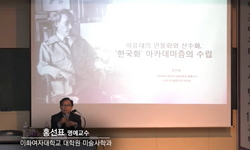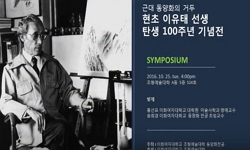Lee Gyu Sun(李奎鮮, 1938~2014), also known for his art name Namgye(南溪), was a painter who created his own distinctive style of abstract paintings in Korean painting. During his undergraduate degree in painting at Seoul National University Colle...
http://chineseinput.net/에서 pinyin(병음)방식으로 중국어를 변환할 수 있습니다.
변환된 중국어를 복사하여 사용하시면 됩니다.
- 中文 을 입력하시려면 zhongwen을 입력하시고 space를누르시면됩니다.
- 北京 을 입력하시려면 beijing을 입력하시고 space를 누르시면 됩니다.
https://www.riss.kr/link?id=A107306474
- 저자
- 발행기관
- 학술지명
- 권호사항
-
발행연도
2021
-
작성언어
-
- 주제어
-
KDC
900
-
등재정보
KCI등재
-
자료형태
학술저널
-
수록면
39-66(28쪽)
-
KCI 피인용횟수
0
- DOI식별코드
- 제공처
-
0
상세조회 -
0
다운로드
부가정보
다국어 초록 (Multilingual Abstract)
As such, he stood out for abstract paintings in venue art, but for commercial paintings, he prolifically drew small-sized portraits of children. From the mid-and late 1970s, he added some primary colors to the black base screen and attempted to divide faces with a smooth curve. In the 1990s, he focused more on flat abstraction in black and white, showing a delicate difference derived from traces of black ink brush strokes. In the series of Sichang Cheonggong and Seochang Cheonggong, which began in the 2000s, he attempted an arrangement of the scenery between the opening windows made of Korean traditional paper. Hence, he attempted to express the feelings and inspirations that arise from objects or situations as images rather than focus on the concepts, theories, and narratives of traditional painting. By choosing abstraction in the sense of contemporary painting, ink and nature motifs in that of oriental painting, and primary colors in that of Korean painting, Lee Gyu Sun's unique signs of modernity, orientality, and Koreanness were created. This can be considered the characteristic of abstract painting by Gyu Sun Lee.
Lee Gyu Sun(李奎鮮, 1938~2014), also known for his art name Namgye(南溪), was a painter who created his own distinctive style of abstract paintings in Korean painting. During his undergraduate degree in painting at Seoul National University College of Fine Arts, he first studied oil painting. He then studied both oriental and western paintings, submitting his works of oriental and western paintings to the relevant departments of the National Art Exhibition of The Republic of Korea. However, since the 19th National Art Exhibition in 1970, participating in the Nonrepresentalism Category of the Department of Oriental Painting only, he began to pursue abstractness in earnest. The entries during this period are known for the features like the geometric area division created by the intersection of straight lines, the use of thick coloring and whitewash, and the design of stains using the spray technique.
As such, he stood out for abstract paintings in venue art, but for commercial paintings, he prolifically drew small-sized portraits of children. From the mid-and late 1970s, he added some primary colors to the black base screen and attempted to divide faces with a smooth curve. In the 1990s, he focused more on flat abstraction in black and white, showing a delicate difference derived from traces of black ink brush strokes. In the series of Sichang Cheonggong and Seochang Cheonggong, which began in the 2000s, he attempted an arrangement of the scenery between the opening windows made of Korean traditional paper. Hence, he attempted to express the feelings and inspirations that arise from objects or situations as images rather than focus on the concepts, theories, and narratives of traditional painting. By choosing abstraction in the sense of contemporary painting, ink and nature motifs in that of oriental painting, and primary colors in that of Korean painting, Lee Gyu Sun's unique signs of modernity, orientality, and Koreanness were created. This can be considered the characteristic of abstract painting by Gyu Sun Lee.
참고문헌 (Reference)
1 이규선, "한국회화의 전통과 그 계승 발전의 문제_이조회화를 중심으로" 이화여자대학교 미술대학동양화과 2 : 1970
2 이민수, "한국화 형상 표현과 현실 인식의 재조명–1930년대 이후 국내 화단의 구상․추상 논쟁을 중심으로" 홍익대학교 2019
3 오광수, "한국현대미술사 : 1900년대 도입과 정착에서 1900년대 오늘의 상황까지" 열화당 1997
4 신영상, "한국근현대예술사구술채록연구시리즈: 20세기 한국 서화전통의 변모와 현대화 Ⅰ, 신영상" 한국문화예술위원회 2009
5 임송희, "한국근현대예술사구술채록연구시리즈 : 20세기 한국 서화전통의 변모와 현대화Ⅰ, 임송희" 한국문화예술위원회 2009
6 민경갑, "한국근현대예술사구술채록연구시리즈 : 20세기 한국 서화전통의 변모와 현대화Ⅰ, 민경갑" 한국문화예술위원회 2009
7 이규선, "축제"
8 이규선, "축제"
9 이규선, "채향"
10 이규선, "작품 87-9"
1 이규선, "한국회화의 전통과 그 계승 발전의 문제_이조회화를 중심으로" 이화여자대학교 미술대학동양화과 2 : 1970
2 이민수, "한국화 형상 표현과 현실 인식의 재조명–1930년대 이후 국내 화단의 구상․추상 논쟁을 중심으로" 홍익대학교 2019
3 오광수, "한국현대미술사 : 1900년대 도입과 정착에서 1900년대 오늘의 상황까지" 열화당 1997
4 신영상, "한국근현대예술사구술채록연구시리즈: 20세기 한국 서화전통의 변모와 현대화 Ⅰ, 신영상" 한국문화예술위원회 2009
5 임송희, "한국근현대예술사구술채록연구시리즈 : 20세기 한국 서화전통의 변모와 현대화Ⅰ, 임송희" 한국문화예술위원회 2009
6 민경갑, "한국근현대예술사구술채록연구시리즈 : 20세기 한국 서화전통의 변모와 현대화Ⅰ, 민경갑" 한국문화예술위원회 2009
7 이규선, "축제"
8 이규선, "축제"
9 이규선, "채향"
10 이규선, "작품 87-9"
11 이규선, "이동주점"
12 정병관, "오늘의 작가 연구 南溪 李奎鮮_해학이 깃든 즐거운 추상" (가을) : 1983
13 이규선, "여일"
14 이규선, "여운"
15 이규선, "여래"
16 이규선, "시창청공"
17 이규선, "부두"
18 이규선, "미몽"
19 이규선, "무제"
20 이규선, "달"
21 이규선, "건어장"
22 이규선, "가을 아이들"
23 정무정, "南溪 李奎鮮" 이천시립월전미술관 2014
24 윤난지, "南溪 李奎鮮" 이천시립월전미술관 2014
25 김경연, "1970년대 한국 동양화 추상 연구 - 국전 동양화 비구상부문을 중심으로" 한국미술사교육학회 32 : 75-100, 2016
26 송희경, "1970년대 ‘소폭’ 동양화의 시각성과 그 교양적 기능-남정 박노수(藍丁 朴魯壽, 1927~2013)의 ‘시가 있는 그림’을 중심으로-" 동아시아문화연구소 (72) : 51-72, 2018
27 송희경, "1950년대 동양화단의 민족성 담론과 그 실체" 한국미술연구소 (50) : 299-321, 2020
28 박파랑, "1950~60년대 한국 동양화단의 추상미술 수용과 전개 : 전후 일본 미술계와의 관계를 중심으로" 弘益大學校 2017
동일학술지(권/호) 다른 논문
-
- 한양대학교 동아시아문화연구소
- 오택현 ( Oh Taek-hyun )
- 2021
- KCI등재
-
재조선 일본인 문학의 ‘경성’ 재현 양상과 심상지리 연구
- 한양대학교 동아시아문화연구소
- 권은 ( Kwon Eun )
- 2021
- KCI등재
-
경성제대 출신 귀환자들의 정체성 형성과 한국인 동창 -동창회지 『청구(青丘)』·『감벽(紺碧)』을 중심으로-
- 한양대학교 동아시아문화연구소
- 김욱 ( Kim Wook )
- 2021
- KCI등재
-
역사적·정치적 병리에 대한 텔레비전드라마 <상어>의 상상력
- 한양대학교 동아시아문화연구소
- 윤석진 ( Yun Suk-jin )
- 2021
- KCI등재
분석정보
인용정보 인용지수 설명보기
학술지 이력
| 연월일 | 이력구분 | 이력상세 | 등재구분 |
|---|---|---|---|
| 2027 | 평가예정 | 재인증평가 신청대상 (재인증) | |
| 2021-01-01 | 평가 | 등재학술지 유지 (재인증) |  |
| 2018-01-01 | 평가 | 등재학술지 유지 (등재유지) |  |
| 2015-01-01 | 평가 | 등재학술지 유지 (등재유지) |  |
| 2011-01-01 | 평가 | 등재학술지 선정 (등재후보2차) |  |
| 2010-01-01 | 평가 | 등재후보 1차 PASS (등재후보1차) |  |
| 2009-11-06 | 학회명변경 | 한글명 : 한국학연구소 -> 동아시아문화연구소영문명 : 미등록 -> Institute for East Asian Cultures |  |
| 2009-11-04 | 학술지명변경 | 한글명 : 한국학논집 -> 동아시아문화연구외국어명 : The Journal of Korean Studies -> Journal of East Aisan Cultures |  |
| 2008-01-01 | 평가 | 등재후보학술지 선정 (신규평가) |  |
학술지 인용정보
| 기준연도 | WOS-KCI 통합IF(2년) | KCIF(2년) | KCIF(3년) |
|---|---|---|---|
| 2016 | 0.44 | 0.44 | 0.43 |
| KCIF(4년) | KCIF(5년) | 중심성지수(3년) | 즉시성지수 |
| 0.44 | 0.41 | 0.784 | 0.34 |




 KCI
KCI KISS
KISS






